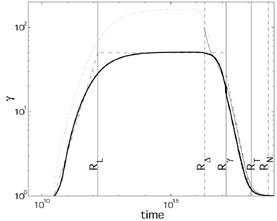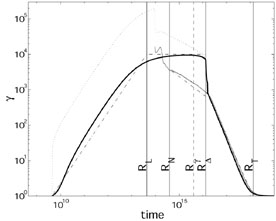


5.3. Typical Radii
| Ri | Initial Radius | c
 t t |
 107 - 108 cm
107 - 108 cm |
R |
Matter dominates | Ri |
 109 cm
109 cm |
| Rpair | Optically thin to pairs | [(3E / 4 Ri3 a)1/4 /
Tp] Ri
Ri3 a)1/4 /
Tp] Ri |
 1010 cm
1010 cm |
| Re | Optically thin |
( T E /
4 T E /
4 mp
c2 mp
c2
 )1/2 )1/2 |
 1013 cm
1013 cm |
R |
Internal collisions | 
 2 2 |
 1012 - 1014 cm
1012 - 1014 cm |
R |
External Newtonian Shocks | l
 -2/3 -2/3 |
 1016 cm
1016 cm |
R |
External Relativistic shocks | l3/4
 1/4 1/4 |
 1016 cm
1016 cm |
| l or L | Non relativistic external shock | l (a) or
l -1/3
(b) -1/3
(b) |
 1017 - 1018 cm
1017 - 1018 cm |
| l | Sedov Length | l = (3E /
4 nism mp
c2)1/3
nism mp
c2)1/3 |
 1018 cm
1018 cm |
Figs. 12 and 13 (from [228]) depict a numerical solution of a fireball from its initial configuration at rest to its final Sedov phase.
 |
Figure 12. Fireball evolution from its initial
formation at rest to the final Newtonian Sedov solution. The energy
extraction is due to the interaction with the ISM via a
relativistic forward shock and a Newtonian reverse shock. We have used
for this calculations
|
 |
Figure 13. Fireball evolufrom its initial
formation at rest to the final Newtonian Sedov solution. The energy
extraction is due to the interaction with the ISM via relativistic
forward and reverse shocks. The parameters for this computation are:
|